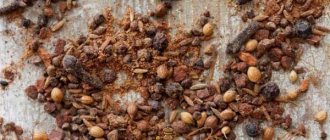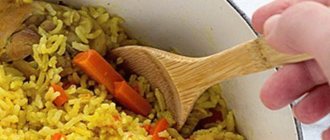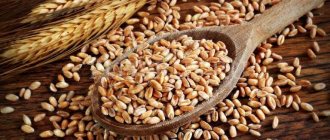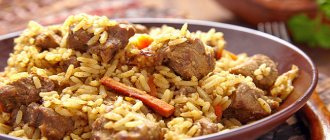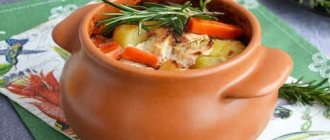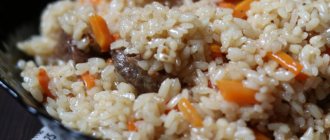3
Prepared by: Anton Soroka
08/15/2018 Cooking time: 50 min
| Save | I cooked) | Estimate |
Indian pilaf is something! And it is prepared with chicken, ginger and turmeric, usually on holidays. I am sharing a recipe for making Chicken Biryani, it will be delicious!
Ingredients:
- Long grain rice or basmati - 150 grams
- Chicken thighs – 4 pieces
- Salt, pepper - To taste
- Vegetable oil - 2 tbsp. spoons
- Onion – 1 piece
- Fresh ginger - To taste (4 cm)
- Turmeric – 1 teaspoon
- Cardamom - 0.5 teaspoons
- Cinnamon stick – 1 piece
- Bay leaf – 1 piece
- Raisins - 0.5 cups
- Broth or water - 2.5 cups
- Almonds – 1/4 Cup
- Cilantro - To taste
Number of servings: 4-6
Vegetarian recipe
Considering the most popular recipes for Biryani pilaf, one cannot fail to mention the vegetable variation of this dish, which is in high demand in Pakistani and North Indian cuisine. The appetizer is prepared from various combinations of vegetables and rice - it all depends on the imagination and individual preferences of the chef. However, the obligatory ingredients of such pilaf are potatoes, garam masala and, of course, basmati rice.
Let's try to recreate the harmonious taste of vegetarian pilaf Biryani, using one of the proven Indian recipes. To prepare the snack you will need:
- 400 grams of basmati,
- vegetables – carrots, broccoli, cauliflower, bell pepper, potatoes – total weight 600 grams,
- 150 grams of hard cheese,
- half a standard can of canned peas and corn,
- about 5 cm of medium-thick ginger root,
- one and a half teaspoons of cumin, mustard seeds and turmeric,
- half a teaspoon of coriander,
- 1 piece of star anise,
- 7 black peppercorns
- 1 cinnamon stick,
- 4 tablespoons soft butter,
- salt to taste.
How to make Chicken Biryani
1. Place rice in a bowl, fill it with water and rinse thoroughly, then repeat the procedure several times until the water is clear.
2. Wash the chicken thighs, cut each one along the bone, and rub with salt and pepper. Fry the meat in a frying pan until golden brown, then transfer to a plate.
3. Finely chop the onion and ginger root, fry in the pan in which the chicken was fried, add cardamom and turmeric. Add rice to the contents of the pan and stir, then add chicken, raisins, cinnamon, bay leaf, and add water or broth.
4. After the liquid boils, reduce the heat, cover the pan with a lid and cook for 15-20 minutes (until the rice is soft). Once ready, let the dish sit for 5-7 minutes.
5. Remove the bay leaf and cinnamon from the pilaf. Fry the nuts in a separate frying pan and add them to the pilaf. Serve the dish immediately after cooking, garnished with cilantro. Bon appetit!
Subtleties of cooking
It is quite difficult to recreate the classic taste of this Indian dish in your own kitchen - this requires unique spices, herbs and special utensils that oriental housewives use to stew rice. Small clay pots, in which it is ideal to cook Biryani pilaf, are distinguished by a thick bottom, a tight lid and sloping walls, due to which all the condensation that evaporates during cooking goes back into the rice, giving it a special juiciness and delicate texture. That is why the national dish does not require a large amount of water - not a single drop leaves the tightly sealed pot during heat treatment.
However, if you have a classic ceramic pot, cauldron, or at least a thick-walled saucepan on hand, you can try step by step to recreate the delicious taste of Biryani, as close as possible to the national one. To do this you will need the following set of products:
- oriental basmati rice – 1 cup without a slide,
- chicken fillet (it is better to take thigh pulp) – 400-450 grams,
- low-fat natural yoghurt without any flavoring additives – 80 ml,
- 1 onion,
- 2 tablespoons softened butter,
- finely grated ginger root - half a teaspoon,
- half a teaspoon each of turmeric, cumin, ground hot pepper (the amount of spices can be changed depending on taste preferences),
- salt, freshly squeezed lemon juice, cilantro - to taste,
- 2 sticks of cloves,
- 3-4 mint leaves (can be dry),
- 2 cloves of garlic.
In addition, for Biryani pilaf you will need the national Indian seasoning garam masala, which, however, you can prepare yourself, having the following set of spices and herbs on hand:
- half a tablespoon of cumin, black pepper (not ground), dried ginger, cardamom,
- 2 tablespoons coriander,
- 2 sticks of cloves,
- a pinch of cinnamon,
- 2-3 bay leaves.
Having prepared all the necessary ingredients, you can begin preparing Biryani pilaf step by step, and a detailed recipe with photos and recommendations will help you not get confused in this rather complex process.
DIY garam masala
To prepare an oriental mixture of spices and seeds, you need to thoroughly heat each ingredient, with the exception of ginger, in a dry frying pan, after clearing the cardamom from the chaff. Then, while the spices have not yet completely cooled, you need to grind them in a mortar until smooth, trying not to crush, but to knead the hot seeds. If you don’t have a mortar at hand, you can grind the calcined spices in a blender and coffee grinder - this will slightly change the final consistency and richness of the aroma, but not so critically that it will affect the final taste of the dish.
Meat preparation
- Peel the chicken fillet or thigh pulp from skin, films and fat inclusions, and then cut into large pieces.
- Cut the onion into thin rings, peel the garlic and pass through a press.
- Sprinkle each chicken piece with chili, grated ginger, chopped dried mint, cilantro and about half of the resulting garam masala, top with onion rings and garlic, and then pour natural yoghurt so that the dressing evenly covers the fillets.
- Sprinkle turmeric on top of the marinated meat and pour lemon juice over it - this will give the pulp a deeper aroma and speed up the marinating process.
- Leave the fillet pieces in the spicy yoghurt marinade for about 30-40 minutes. During this time, the chicken flesh will be saturated with the delicate yoghurt taste and tart aroma of a cocktail of spices.
Cooking rice
In principle, there is nothing complicated in classic cooking of rice - everyone who has ever cooked crumbly rice porridge is familiar with the process. To do this, bring 2 cups of water to a boil, add salt, add basmati, reduce heat to low and cook until the liquid boils by about half (about 5-7 minutes). And to give the cereal a rich aroma, you should place cloves, bay leaves, cumin and pepper in a gauze napkin, secure the edges, forming a bag, and also place it in the pan during cooking. On the one hand, this will allow each grain to be filled with a deep and rich spicy taste, and on the other hand, it will greatly facilitate the subsequent extraction of inedible spices from the pilaf.
The final stage
- When the chicken is marinated, fry it in butter until golden brown.
- Separately, lightly fry the onion rings until they become translucent and less crispy.
- Place the chicken on top of the rice, then the onion rings, top with the remaining garam masala and fill with water to about half the total volume.
- Close the pan tightly with a lid, place on low heat and simmer for about half an hour until fully cooked.
Biryani pilaf should be served hot, first sprinkled with chopped herbs. You can accompany the snack with a bowl of natural yogurt and fresh vegetables - this will make the taste of the dish even more tender and softer.
Vegetarian biryani: step-by-step recipe with photos
Biryani is Indian rice with vegetables in a yoghurt-tomato sauce, richly flavored with spices. Usually biryani is prepared from whatever is available in the house at that moment. You can use any vegetables you like. If you are not a vegetarian, you can make biryani with mutton, chicken or pork. The most important thing in this recipe is the constant Basmati rice and the right set of Indian spices. The recipe is very simple, although it takes about half an hour to prepare.
Ingredients for "Vegetarian Biryani" for 4-5 servings:
Cauliflower - small head
Carrots - 1 piece
Green beans - 200 grams
Ghee (clarified butter) - 3 tbsp. spoons
Kerd (fermented milk Indian drink) or unsweetened yogurt - 4 tbsp. spoons
Tomato paste - 2 tbsp. spoons
Garlic – 5 cloves
Fresh coriander - 20 grams
Fresh mint - 20 grams
Green onions - 20 grams
Salt - to taste
Indian Spices for Vegetarian Biryani:
Turmeric - 2 tsp.
Garam masala - 1 tsp.
Mango powder (dry and grated mango) - 1 tsp.
Chat masala - 1 tsp.
As for ingredients, if you can't find fresh coriander or mint, you can do without them. But I would recommend adding Indian spices to everything in the recipe, because they give the dish a subtle oriental aroma and taste.
Many people call biryani Indian pilaf, but there is a fundamental difference in preparation. In pilaf, rice is cooked in a rich broth, and in the Indian version, stewed vegetables with spices are first prepared, and then boiled rice is added to them.
First you need to cook the rice. Rinse the rice well and fill it with cold water so that there is a lot of water, because we will then salt out the excess liquid. Put it on fire. The basmati rice will cook for about 20 minutes.
In another pan, place the cauliflower, disassembled into inflorescences, carrots cut into cubes and green beans. Do not add salt to the water, just add a teaspoon of turmeric. This will add color to the vegetables.
Turmeric occupies a very important place in the Indian kitchen. It not only adds a beautiful yellow-orange color to dishes, but also helps provide first aid to family and friends. Turmeric is sprinkled on burns and cuts to help them heal faster.
When the vegetables are half cooked, remove them from the heat and drain the water.
Taste the rice. If it's cooked, you can drain the water. Attention, there is no need to rinse basmati rice with cold or hot water. It will be crumbly anyway, that’s just the way it is.
Place 3 tablespoons of Ghee in a frying pan. This is butter, melted and processed in a special way. If there is no Ghee, then regular butter will do.
Fry five cloves of garlic in oil, finely chopping them.
Place vegetables in the pan. Mash the cauliflower slightly with a spatula so that the pieces are smaller.
Add chopped green onions, fresh coriander and fresh mint to the vegetables. Mix everything.
Now is the time to add 4 tablespoons of yogurt and 2 tablespoons of tomato paste.
When everything has simmered together for 3-4 minutes, add boiled rice and stir.
And just now add salt to taste.
At the end, the final touch is Indian spices: Garam masala, Mango powder, Chat masala and turmeric. One teaspoon of each spice. Mix everything well and remove from heat.
Vegetarian biryani is ready. It's time to put it on a plate and invite guests to the table. The dish is very filling. A light vegetable Raita goes well with it, as well as Chicken Sagwala (if you are a meat eater) or Shahi Paneer (if you are a vegetarian).
If you like Asian food, but are just learning to understand the intricacies of cooking, you will find my posts useful:
Indian cuisine: description, 34 photos
Food in Vietnam: dishes, descriptions, photos
Cuisine of Malaysia: names, photos, description
Do you like the blog Soblakami.ru ? I have many more recipes and interesting stories from our travels. Subscribe to announcements of new posts in groups on social networks or by email. All the necessary buttons are at the bottom of the page.
How to cook Indian pilaf
Place a frying pan on the stove, pour in vegetable oil. Heat it up, put all the spices in the frying pan. Fry them over medium heat for five minutes.
Peel the onions and carrots. Wash the vegetables, cut the onion into cubes, and grate the carrots on a coarse grater. Add onions, carrots, and green peas to the pan and simmer for five minutes.
Disassemble the head of garlic into cloves and peel each one. Then pour boiling water over the tomato, remove the skin and cut the vegetable into thin slices. Add the tomato and garlic cloves to the pan.
Rinse the rice and add to the vegetables. Sprinkle everything with the prepared seasoning, add salt to taste. Mix all ingredients thoroughly.
Fill the ingredients with water so that it covers them by two fingers. Cover the pan with a lid, reduce heat to low and simmer until the liquid has evaporated. Add raisins at the end. Serve the dish to the table.
